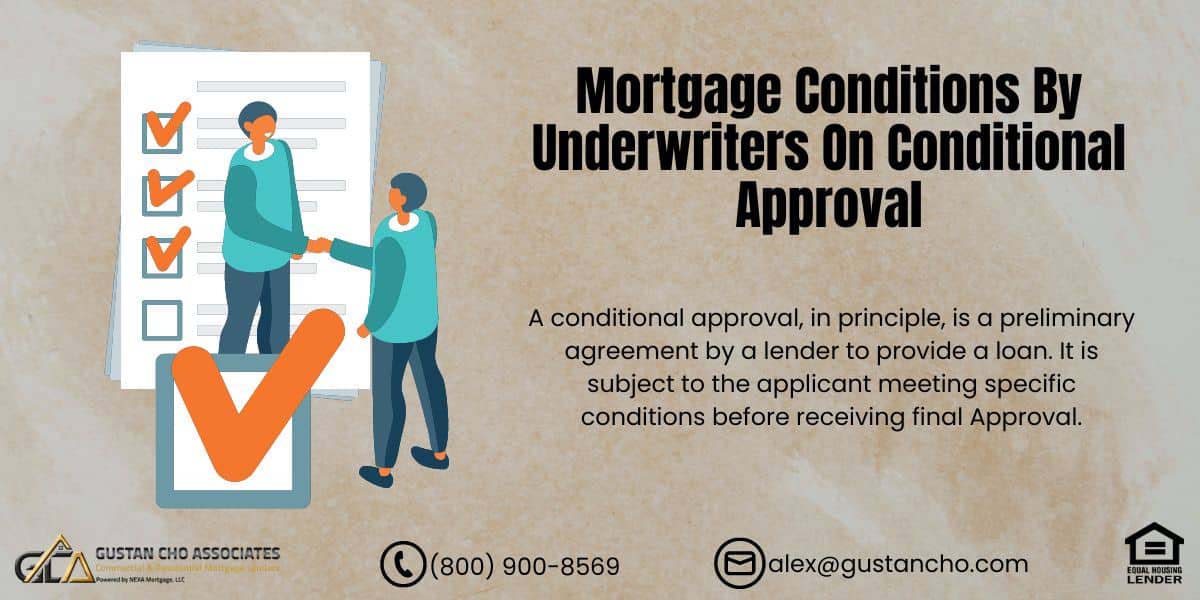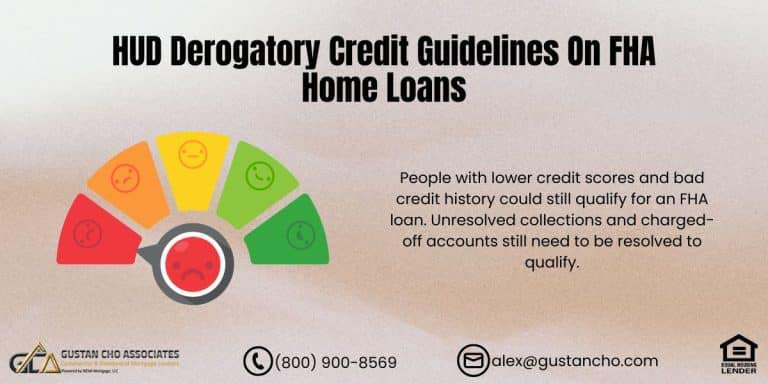In this article, we will discuss and cover mortgage conditions by underwriters on conditional loan approvals. Once the mortgage loan has been processed, it will get submitted to the mortgage company’s underwriting department. It is then assigned to a mortgage underwriter. A mortgage underwriter will carefully look at borrowers’ loan applications. All loan documents submitted will be carefully reviewed and analyzed.
The following documents need to be complete without missing pages and up to date:
- two years tax returns
- two year W-2s
- 30 days paycheck stubs
- 60 days of bank statements
- credit report
Other documents that apply to borrowers such as the following:
- bankruptcy paperwork
- foreclosure paperwork
- short sale paperwork
- divorce decree
- pension agreements
- child support paperwork, etc.
What is a Conditional Approval in Principle?
A conditional approval, in principle, is an initial agreement given by a lender or insurer that outlines their willingness to provide a loan or insurance policy, pending the fulfillment of certain conditions. It is sometimes called a “pre-approval” or “provisional approval.”
Got Conditional Approval? Let Us Help You Clear the Underwriting Conditions Quickly!
Apply Now And Get recommendations From Loan Experts
Here’s a more detailed explanation:
- Preliminary Assessment: The lender or insurer evaluates the applicant’s initial information, such as credit history, income level, or health, to decide if the applicant appears to qualify for the loan or insurance product.
- Stipulations Provided: The conditional approval comes with specific requirements or stipulations (underwriting conditions) that must be met before the final approval is granted. For instance:
- For a mortgage, it could require an official appraisal of the property.
- For a personal loan, you need verified income statements.
- For insurance, medical exams or more in-depth questionnaires might be necessary.
- Final Approval: Once the applicant has met specific conditions, the lender or insurer will perform a final review to determine whether to approve or deny the application.
A clear to close is when the mortgage underwriter is ready to fund the home loan. Overall, conditional approval gives applicants an understanding of their position, enabling them to plan or make offers more confidently. However, it’s a final guarantee once all conditions are satisfied.
Once a mortgage underwriter has reviewed all of the documents provided and feels comfortable borrowers qualify and meet all guidelines, the underwriter will issue a conditional loan approval. Most borrowers feel that they are totally approved once they get conditional mortgage approval. This is true but the keyword here is conditions.
What is the Difference Between Conditional Approval and Unconditional Approval?
The difference between conditional and unconditional approval is that additional requirements or conditions must be met before final approval is granted.
- Conditional Approval:
- Definition: An approval subject to the applicant fulfilling specific conditions set by the lender or insurer.
- Example Conditions:
- Verifying income through recent pay stubs or tax returns.
- Providing additional documentation, like an appraisal report for a property.
- Passing a medical exam for an insurance policy.
- Implication: The approval is still being determined, and the applicant must complete the required tasks before receiving the final offer.
- Unconditional Approval:
- Definition: An unconditional approval confirms that all requirements have been met without further conditions.
- Final Stage: Once the applicant has unconditional approval, the agreement (loan or insurance policy) can proceed without additional requirements or reviews.
- Implication: This final approval often enables immediate action, such as finalizing a property purchase or initiating insurance coverage.
In essence, conditional approval is a step toward securing a loan or policy. In contrast, unconditional approval confirms that all conditions have been met and the agreement can be formalized.
Conditional Approval Received? Let Us Help You Clear Those Conditions Fast!
Your conditional approval is a great start, now let’s work on meeting the underwriting conditions to get you to the closing table. Contact us today to keep the process moving.
Additional Conditions After Submitting Mortgage Conditions
There are many times where underwriters will request additional conditions not requested on the initial conditional mortgage loan approval. This is when many mortgage loan applicants, mortgage processors, and mortgage loan originators get extremely frustrated.
A seasoned experienced competent mortgage underwriter should not request additional conditions after she issues an initial condition list. This is normally the case unless the mortgage conditions requested are incomplete or not the condition initially requested.
Most experienced mortgage processors will not submit incomplete conditions. It normally takes 24 to 72 hours for a mortgage underwriter to review mortgage conditions. Submitting incomplete mortgage conditions can cause delays in the mortgage application process. I can possibly cause delays in mortgage closing.
If additional conditions are requested, everyone has no other choice but to comply with the additional conditions request.
Clear To Close
Once the mortgage underwriter has reviewed all mortgage conditions, she will issue a clear to close. Once a clear to close has been issued, the mortgage docs are prepared by the mortgage lender and sent to the title company. The wire is sent to fund the mortgage loan.
What Is QC?
QC, or Quality Control, is another mortgage underwriting process after a clear to close has been issued by the original mortgage underwriter. A QC underwriter is assigned to overlook the work of the initial mortgage loan underwriting. Quality Control is not implemented by all mortgage companies.
Only a certain percentage of mortgage companies have a QC underwriting review process. A QC underwriter can come up with more conditions from the loan applicant. Most QC process takes 24 hours to 48 hours to complete.
However, it can take much longer. Borrowers applying for a home loan, find out if the mortgage company the file is being submitted to has a QC process. If they do, try to go to another lender that does not have a QC underwriting process. I have had an extremely bad experience where a whole mortgage file got delayed after the initial clear to close by a mortgage underwriter do to QC underwriting. Why have a mortgage underwriter issue a clear to close if it needs to be re-underwritten.
If you have any questions on how does FHA define family member or borrowers who need to qualify for FHA loans with a lender with no overlays on government or conforming loans, please contact us at 800-900-8569. Text us for a faster response. Or email us at alex@gustancho.com. The team at Gustan Cho Associates is available 7 days a week, on evenings, weekends, and holidays.
FAQ: Mortgage Conditions By Underwriters On Conditional Approval
- What is conditional Approval in principle? A conditional approval, in principle, is a preliminary agreement by a lender or insurer to provide a loan or insurance policy. It is subject to the applicant meeting specific conditions before receiving final Approval. Often referred to as “pre-approval,” it involves a preliminary assessment based on initial information like credit history, income level, or health.
- How are conditional loan approvals issued? Conditional loan approval is issued after a mortgage underwriter thoroughly reviews the applicant’s submitted documents, such as income verification and credit reports. Suppose the underwriter feels confident that the borrower meets all guidelines. In that case, they will grant conditional Approval, meaning the borrower must meet specific conditions before finalizing the Approval.
- What is the difference between conditional and unconditional Approval? Conditional Approval involves requiring applicants to fulfill additional requirements, such as verifying income, providing an appraisal report, or passing a health check before receiving final Approval. Unconditional Approval confirms that all conditions have been satisfied, allowing the agreement to proceed to immediate action, like finalizing a property purchase or insurance coverage.
- What documents are needed for conditional approval? When submitting your application, you must furnish your tax returns for the last two years, W-2 forms, recent paycheck stubs that date back 30 days, bank statements that date back 60 days, and a credit report. Additional documents may include paperwork related to bankruptcy, foreclosure, short sales, divorce decrees, pension agreements, and child support paperwork.
- What happens if additional conditions are requested after submitting the initial documents? Mortgage underwriters sometimes request additional conditions after reviewing the initial documents. These conditions can arise if the original documents need to be completed or do not fully meet the underwriter’s expectations. It’s important to comply with these additional requests promptly to avoid delays.
- What is a “clear to close”? A “clear to close” is issued when a mortgage underwriter reviews and approves all conditions. It signals that the loan is ready to be funded, and the mortgage documents are prepared and sent to the title company. At this stage, the wire is sent to fund the loan.
- What does QC mean in mortgage underwriting? QC stands for Quality Control, a process where a QC underwriter reviews the initial underwriter’s work after issuing a clear to close. Not all lenders have this process, but those that do might uncover additional conditions that require fulfillment. This step may prolong the closing process, but it is necessary to guarantee that the highest quality standards are achieved.
Related> What is clear to close?
Related> What is conditional approval?
This blog about Mortgage Conditions By Underwriters On Conditional Approval was updated on May 7th, 2024.
Conditional Approval on Your Mortgage? Let’s Work Together to Meet Underwriting Conditions!
Reach out today to understand the conditions and get your mortgage to the finish line.










